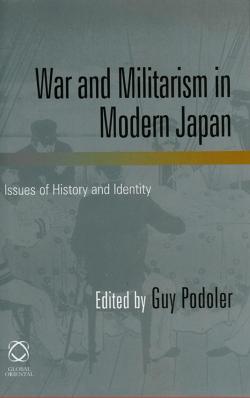War and Militarism in Modern Japan, Issues of History and Identity

edited by Guy Podoler, Global Oriental, 2009, 242 pages including index and bibliography, ISBN978-1-905246-85-4
Review by Sir Hugh Cortazzi
This collection of essays reproduces papers prepared for “The International Conference on Japan in Honour of Professor Ben-Ami Shillony,” which took place at the Hebrew University of Jerusalem in Israel between 29 April and 2 May 2007. It was intended as a tribute to Professor Shillony’s significant contribution to Japanese studies and marked his retirement as well as his seventieth birthday.
The book is in three parts. The first part looks at aspects of war and militarism in modern Japan. The second part is “dedicated to research that sheds light on the features of identity by inferring from war-related historical events and phenomena;” and the last part critically explores “conscious and intentional acts of identity formation that were affected by the history under discussion.” I am not sure that I understand this statement by the editor in his introduction, but there are a number of essays in this book which eschew jargon and do throw interesting light on aspects of Japanese modern history.
The first essay by Ian Nish entitled “Japan’s Tug-of-War after the Russo-Japanese War” deals with the growing power of the army in the years immediately following the Russo-Japanese war of 1904/5. Professor Nish notes that the army “was split into groups advocating restraint and those favouring expansion (page 19).” General Katsura (桂 太郎) saw himself as a moderate figure.
General Yamagata (山縣 有朋) backed the expansion of the army, Both “groups contrived to present a common front against the politicians, the political parties and the bureaucrats who found it difficult to exert civilian control over them (page 21).”
The second essay by Naoki Maruyama entitled “Facing a Dilemma: Japan’s Jewish Policy in the Late 1930s” discuses the benign attitude of the Japanese authorities towards the Far Eastern Jewish National Conference in Harbin in December 1937 despite Japan’s participation in the Anti-Comintern Pact with Nazi Germany. The Japanese authorities in Manchuria thought that the Jewish community could play a constructive role in the economic development of Manchukuo and could help to bring in American capital, but as Japan’s relations grew closer with Nazi Germany, Japanese support dwindled. However despite Nazi Germany’s persecution of the Jews, Jewish refugees in the Far East “were not subject to forced labour or extermination (page 36).”
Jennifer Robertson’s essay “Ethnicity and Gender in the Wartime Japanese Revue Theatre” shows how the all female cast of Takarazuka opera was exploited to support Japanese war-time policies and propaganda. Unfortunately her style is dense. Readers may well need to read twice sentences such as: “Although the relationship between the Takarazuka Revue, a private corporation, and the imperial state was one of mutual opportunism as opposed to seamless consensus, the ‘cross ethnicking’ performed by the cross-dressed actors was homologous to the official rhetoric of assimilation which equated Japanese expansion with a mission to ‘civilize’ through Japanization the peoples of Asia and the South Seas (page 40).”
Another essay by Irmala Hijiya-Kirschnereit notes that contrary to what one might have expected Yukio Mishima (三島 由紀夫) “in contrast to many post-war authors…hardly ever deals with the subject of war in his narratives.”
Rotem Kowner‘s essay “Imperial Japan and Its POWs: the Dilemma of Humaneness and National Identity” outlines the deterioration in Japanese attitudes to prisoners of war from the time of the Sino-Japanese War of 1894/5 to the Second World War. We should note: “In March 1941 The Japanese army in China instructed soldiers that on being taken prisoner their orders were to escape immediately or commit suicide (page 89).”
The article by Mark Peattie entitled “Japan’s Defeat in the Second World War: The Cultural Dimension” is an interesting discussion of some of the reasons why Japan could not avoid defeat. He argues (page 112) that “deficiencies in Japanese institutions, weaponry, strategy and tactics all played a significant role,” but he regards the fundamental reason to have been “the narrowness of the value system of Japan’s military leadership.”
Sigal Ben-Rafael Galanti’s article “The Memory of the Second World War and the Essence of ‘New Japan’: The Parliamentary Debate over Japan’s Democratic Constitution” discusses the way in which any collective responsibility is generally denied by Japanese today. He notes for instance that even the famous Japanese liberal politician Yukio Ozaki (尾崎 行雄), who had been imprisoned in both World Wars, who was supportive of Japan’s new constitution and well aware of Japan’s grave problems in the past “…did not consider Japan responsible for crimes against neighbouring peoples (page 137).” In his conclusion he notes that all participants in the debate on the new constitution “ascribed Japan’s involvement and failure in the war to notions such as militarism, capitalism or colonialism, and identified the guilty party in specific groups or figures…none blamed the conduct of Japan as a society, or as a nation, towards other peoples (page 139/140).”
In one of the final essays entitled “A Fragile Balance between ‘Normalization’ and the Revival of Nationalistic Sentiments” Mariko Tsuchiya worries about the possible results from attempts by Japanese conservative politicians “to rationalize political goals with the use of nationalistic sentiments.” She concludes her essay with these words: “When I see a kind of nostalgia towards traditional Japan, and at the same time the on-going right-ward tendency, I feel that it is more than essential to be aware of what might happen when the delicate balance between demands for change and the rising of nationalistic sentiments will collapse (page 198).”
There is much of interest in this collection of essays and it is a worthy tribute to the scholarship of Professor Ben-Ami Shillony, but I do wish all scholars would try harder to write simpler and more comprehensible English.

